<Back to Index>
- Composer Francisco de Asís Tárrega y Eixea, 1852
- Composer Jean Sibelius, 1865
PAGE SPONSOR
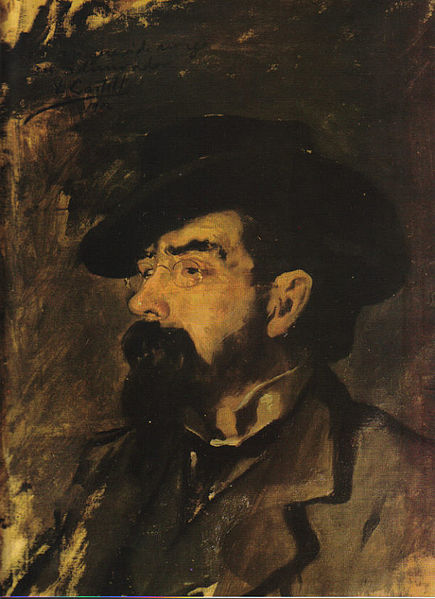
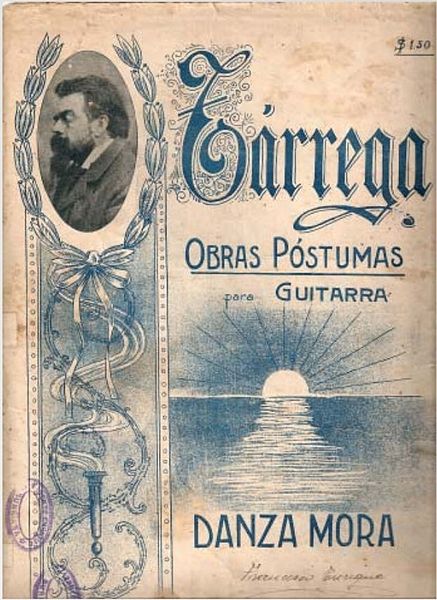
Francisco de Asís Tárrega y Eixea (21 November 1852 – 15 December 1909) was an influential Spanish composer and guitarist of the Romantic period.
Tárrega was born on 21 November 1852, in Villarreal, Province of Castellón, Spain. It is said that Francisco's father played flamenco and several other music styles on his guitar; when his father was away working as a watchman at the Convent of San Pascual the child would take his father's guitar and attempt to make the beautiful sounds he had heard. Francisco's nickname as a child was "Quiquet".
An infection permanently impaired his eyesight and when the family moved to Castelló the child was enrolled in music classes. Both his first music teachers, Eugeni Ruiz and Manuel González, were blind.
In 1862, concert guitarist Julián Arcas, on tour in Castellón, heard the young Tárrega play and advised Tárrega's father to allow Francisco to come to Barcelona to study with him. Tárrega's father agreed, but insisted that his son take piano lessons as well. The guitar was viewed as an instrument to accompany singers, while the piano was all the rage throughout Europe. However, Tárrega had to stop his lessons shortly after, when Arcas left for a concert tour abroad. Although Tárrega was only ten years old, he ran away and tried to start a musical career on his own by playing in coffee houses and restaurants in Barcelona. He was soon found and brought back to his father, who had to make great sacrifices to advance his son's musical education.
Three years later, in 1865, he ran away again, this time to Valencia where he joined a gang of gypsies. His father looked for him and brought him back home once more, but he ran away a third time, again to Valencia. By his early teens, Tárrega was proficient on both the piano and the guitar. For a time, he played with other musicians at local engagements to earn money, but eventually he returned home to help his family.
Tárrega entered the Madrid Conservatory in 1874, under the sponsorship of a wealthy merchant named Antonio Canesa. He had brought along with him a recently purchased guitar, made in Seville by Antonio de Torres. Its superior sonic qualities inspired him both in his playing and in his view of the instrument's compositional potential. At the conservatory, Tárrega studied composition under Emilio Arrieta who convinced him to focus on guitar and abandon the idea of a career with the piano.
By the end of the 1870s, Tárrega was teaching the guitar (Emilio Pujol and Miguel Llobet as well as Daniel Fortea (1878 – 1953) were pupils of his) and giving regular concerts. Tárrega received much acclaim for his playing and began traveling to other areas of Spain to perform. By this time he was composing his first works for guitar, which he played in addition to works of other composers.
During the winter of 1880, Tárrega replaced his friend Luis de Soria, in a concert in Novelda, Alicante,
where, after the concert, an important man in town asked the artist to
listen to his daughter, María José Rizo, who was learning
to play guitar. Soon they were engaged.
In 1881, Tárrega played in the Opera Theatre in Lyon and then the Paris Odeon, in the bicentenary of the death of Pedro Calderón de la Barca. He also played in London, but he liked neither the language nor the weather. There is a story about his visit to England. After a concert, some people saw that the musician was in low spirits. "What is the matter, maestro?" they asked him. "Do you miss home? Your family, perhaps?" They advised him to capture that moment of sadness in his music. Thus, he conceived the theme of one of his most memorable works, Lágrima (literally meaning teardrop). After playing in London he came back to Novelda for his wedding. At Christmas 1882, Tárrega married María José Rizo.
To enlarge his guitar repertory, he soon began transcribing piano works of Beethoven, Chopin, Mendelssohn and others, and, no doubt, to make use of his considerable knowledge of keyboard music. Tárrega and his wife moved to Madrid, gaining their living by teaching privately and playing concerts, but after the death of an infant daughter during the winter, Maria Josefa de los Angeles Tárrega Rizo, they settled permanently in Barcelona in 1885. Among his friends in Barcelona were Isaac Albéniz, Enrique Granados, Joaquín Turina and Pablo Casals.
Francisco Tárrega and María José (María Josefa) Rizo had three more children. Paquito (Francisco), Maria Rosatia (María Rosalia) (best known as Marieta) and Concepción. On a concert tour in Valencia shortly afterward, Tárrega met a wealthy widow, Conxa Martinez, who became a valuable patron to him. She allowed him and his family use of a house in Barcelona, where he would write the bulk of his most popular works. Later she took him to Granada, where the guitarist conceived the theme for his famous Recuerdos de la Alhambra, which he composed on his return and dedicated to his friend Alfred Cottin, a Frenchman who had arranged his Paris concerts.
From the latter 1880s up to 1903, Tárrega continued composing, but limited his concerts to Spain. In 1900 Tárrega visited Argel, where he heard a repetitive rhythm played on an Arabian drum. The following morning he composed his famous Danza Mora based on that rhythm. In about 1902, he cut his fingernails and created a sound that would become typical of those guitarists associated with his school. The following year he went on tour to Italy, giving highly successful concerts in Rome, Naples and Milan.
In
January 1906, he was afflicted with paralysis on his right side, and
though he would eventually return to the concert stage, he never
completely recovered. He finished his last work, Oremus, on 2 December 1909. He died in Barcelona thirteen days later, on 15 December, at the age of 57.
As a composer Tárrega was conservative, his style was similar to the general trends in the second half of the 19th century. A virtuoso on his instrument, he was known as the "Sarasate of the guitar".
Tárrega is considered to have laid the foundations for 20th century classical guitar and for increasing interest in the guitar as a recital instrument. Tárrega preferred small intimate performances over the concert stage. Some believe this was because he played without the nails needed for volume. Others say this was related to his childhood trauma.
Tárrega played with his nails until the last 9 years of his life. He had been playing with shorter nails, and at that point was using only flesh. Andrés Segovia, who established the use of both flesh and nail, when asked for his opinion on Tarrega's use of the right hand without nails, replied:
- "It is absolutely stupid. You reduce the volume of the guitar, and the difference of timbre and color. Tarrega has renounced the real nature of the guitar, which is the richness of its timbres, the different colors of the guitar."
Francisco Tárrega's music and style of guitar playing became strongly influential in the twentieth century. He was central to reviving the guitar as a solo instrument in recital and concerts. His output was modest, having composed only 78 original scores and 120 transcriptions – mostly for his own use. Among his most popular works for the guitar are Recuerdos de la Alhambra, Capricho árabe and Danza Mora.
He is also the composer of what has been claimed to be "probably the world's most heard tune": the Nokia ringtone, Nokia tune, or simply Nokia, also used in advertising spots, is based on Tárrega's Gran Vals. His music also inspired Mike Oldfield to arrange Tárrega's tremolo study Recuerdos de la Alhambra for the soundtrack of the film The Killing Fields.
As with several of his Spanish contemporaries, such as his friend Isaac Albéniz,
he had an interest in combining the prevailing Romantic trend in
classical music with Spanish folk elements, and transcribed several of
Albéniz's piano pieces. The noted contemporary guitarist and
composer Angelo Gilardino has written that Tárrega's 9 Preludios are "... the deepest musical thought of Tárrega in the most concentrated form."
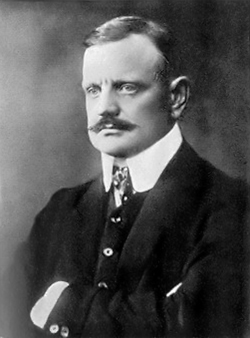
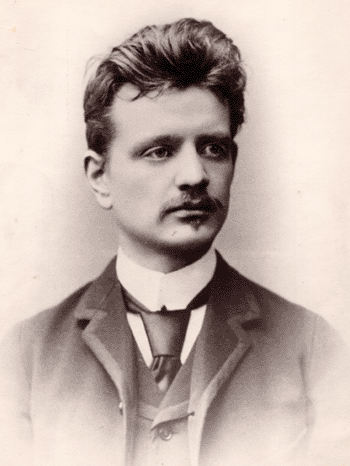
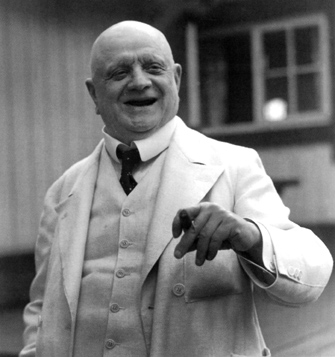
Jean Sibelius (8 December 1865 – 20 September 1957) was a Finnish composer of the later Romantic period whose music played an important role in the formation of the Finnish national identity. His mastery of the orchestra has been described as "prodigious."
The core of Sibelius's oeuvre is his set of seven symphonies. Like Beethoven, Sibelius used each successive work to further develop his own personal compositional style. His works continue to be performed frequently in the concert hall and are often recorded.
In addition to the symphonies, Sibelius's best known compositions include Finlandia, the Karelia Suite, Valse triste, the Violin Concerto in D minor and The Swan of Tuonela (one of the four movements of the Lemminkäinen Suite). Other works include pieces inspired by the Finnish national epic, the Kalevala; over 100 songs for voice and piano; incidental music for 13 plays; the opera Jungfrun i tornet (The Maiden in the Tower); chamber music; piano music; Masonic ritual music; and 21 separate publications of choral music.
Sibelius composed prolifically until the mid 1920s. However, after completing his Seventh Symphony (1924), the incidental music to The Tempest (1926), and the tone poem Tapiola (1926), he produced no large scale works for the remaining thirty years of his life. Although he is reputed to have stopped composing, he in fact attempted to continue writing, including abortive efforts to compose an eighth symphony. He wrote some Masonic music and re-edited some earlier works during this last period of his life, and retained an active interest in new developments in music, although he did not always view modern music favorably.
The Finnish 100 mark bill featured his image until it was taken out of circulation in 2002. Since 2011, Finland celebrates a Flag Day on 8 December, the composer's birthday, also known as the 'Day of Finnish Music'.
Johan Julius Christian Sibelius was born in Hämeenlinna in the Russian Grand Duchy of Finland, the son of Christian Gustaf Sibelius and Maria Charlotta Sibelius. Although known by a typical Finnish name "Janne" to his family, during his student years he began using the French form of his name, "Jean", inspired by the business card of his seafaring uncle. He is now universally known as Jean Sibelius.
Given the rise of the Romantic Nationalism in Europe inspired by the philosophy of Hegel,
it was increasingly customary to forego Latin all around Europe in
favor of the respective local languages. In Finland this meant either
Finnish or
Swedish, from elementary school all the way up to university. Young
Janne Sibelius went to the Finnish speaking Hämeenlinnan normaali lyseo,
which he attended from 1876 to 1885. Romantic Nationalism was to become
a crucial element in Sibelius's artistic output and his political
leanings. From around the age of 15, he set his heart on becoming a
great violin virtuoso, and he did become quite an accomplished player of
the instrument, even publicly performing the last two movements of the Mendelssohn Violin Concerto in Helsinki.
After Sibelius graduated from high school in 1885, he began to study law at the Imperial Alexander University of Finland (now the University of Helsinki). However, he was more interested in music than in law, and he soon quit his studies. From 1885 to 1889 Sibelius studied music in the Helsinki music school (now the Sibelius Academy). One of his teachers there was Martin Wegelius. Sibelius continued studying in Berlin (from 1889 to 1890 with Albert Becker) and in Vienna (from 1890 to 1891). It was around this time that he finally abandoned his cherished violin playing aspirations: "It was a very painful awakening when I had to admit that I had begun my training for the exacting career of a virtuoso too late".
On 10 June 1892, Jean Sibelius married Aino Järnefelt (1871 – 1969) at Maxmo. Their home, called Ainola, was completed at Lake Tuusula, Järvenpää in 1903. They had six daughters: Eva, Ruth, Kirsti (who died at a very young age), Katarina, Margareta and Heidi. Margareta married the conductor Jussi Jalas.
In 1908, Sibelius underwent a serious operation for suspected throat cancer. The impact of this brush with death has been said to have inspired works that he composed in the following years, including Luonnotar and the Fourth Symphony.
Sibelius loved nature, and the Finnish landscape often served as material for his music. He once said of his Sixth Symphony, "[It] always reminds me of the scent of the first snow." The forests surrounding Ainola are often said to have inspired his composition of Tapiola. On the subject of Sibelius's ties to nature, one biographer of the composer, Erik W. Tawaststjerna, wrote the following:
Even by Nordic standards, Sibelius responded with exceptional intensity to the moods of nature and the changes in the seasons: he scanned the skies with his binoculars for the geese flying over the lake ice, listened to the screech of the cranes, and heard the cries of the curlew echo over the marshy grounds just below Ainola. He savored the spring blossoms every bit as much as he did autumnal scents and colors.
The year 1926 saw a sharp and lasting decline in Sibelius's output: after his Seventh Symphony he only produced a few major works in the rest of his life. Arguably the two most significant were incidental music for Shakespeare's The Tempest and the tone poem Tapiola. For most of the last thirty years of his life, Sibelius even avoided talking about his music.
There is substantial evidence that Sibelius worked on an eighth numbered symphony. He promised the premiere of this symphony to Serge Koussevitzky in 1931 and 1932, and a London performance in 1933 under Basil Cameron was even advertised to the public. However, the only concrete evidence for the symphony's existence on paper is a 1933 bill for a fair copy of the first movement. Sibelius had always been quite self critical; he remarked to his close friends, "If I cannot write a better symphony than my Seventh, then it shall be my last." Since no manuscript survives, sources consider it likely that Sibelius destroyed all traces of the score, probably in 1945, during which year he certainly consigned a great many papers to the flames. His wife Aino recalled,
"In the 1940s there was a great auto da fé at Ainola. My husband collected a number of the manuscripts in a laundry basket and burned them on the open fire in the dining room. Parts of the Karelia Suite were destroyed – I later saw remains of the pages which had been torn out – and many other things. I did not have the strength to be present and left the room. I therefore do not know what he threw on to the fire. But after this my husband became calmer and gradually lighter in mood."
On 1 January 1939, Sibelius participated in an international radio broadcast which included the composer conducting his Andante Festivo. The performance was preserved on transcription discs and later issued on CD. This is probably the only surviving example of Sibelius interpreting his own music.
His 90th birthday, in 1955, was widely celebrated and both the Philadelphia Orchestra under Eugene Ormandy and the Royal Philharmonic Orchestra under Sir Thomas Beecham gave special performances of his music in Finland. The orchestras and their conductors also met the composer at his home; a series of memorable photographs were taken to commemorate the occasions. Both Columbia Records and EMI released some of the pictures with albums of Sibelius's music. Beecham was honored by the Finnish government for his efforts to promote Sibelius both in the United Kingdom and in the United States.
Tawaststjerna also related an endearing anecdote regarding Sibelius's death:
[He] was returning from his customary morning walk. Exhilarated, he told his wife Aino that he had seen a flock of cranes approaching. "There they come, the birds of my youth," he exclaimed. Suddenly, one of the birds broke away from the formation and circled once above Ainola. It then rejoined the flock to continue its journey. Two days afterwards Sibelius died of a brain hemorrhage, at age 91 (on 20 September 1957), in Ainola, where he is buried in the garden. Another well known Finnish composer, Heino Kaski, died that same day. Aino lived there for the next twelve years until she died on 8 June 1969; she is buried with her husband.
In 1972, Sibelius's surviving daughters sold Ainola to the State of Finland. The Ministry of Education and the Sibelius Society of Finland opened
it as a museum in 1974. In 2011, a fragment was discovered of what
appeared to be an early draft of the missing eighth symphony.
Like many of his contemporaries, Sibelius was initially enamored of the music of Wagner. A performance of Parsifal at the Bayreuth Festival had a strong effect on him, inspiring him to write to his wife shortly thereafter, "Nothing in the world has made such an impression on me, it moves the very strings of my heart." He studied the scores of Wagner's operas Tannhäuser, Lohengrin, and Die Walküre intently. With this music in mind, Sibelius began work on an opera of his own, entitled Veneen luominen (The Building of the Boat).
However, his appreciation for Wagner waned and Sibelius ultimately rejected Wagner's Leitmotif compositional technique, considering it to be too deliberate and calculated. Departing from opera, he later used the musical material from the incomplete Veneen luominen in his Lemminkäinen Suite (1893). He did, however, compose a considerable number of songs for voice and piano, whose early interpreters included Aino Ackté and particularly Ida Ekman.
More lasting influences included Ferruccio Busoni, Anton Bruckner and Tchaikovsky. Hints of Tchaikovsky's music are particularly evident in works such as Sibelius's First Symphony (1899) and his Violin Concerto (1905). Similarities to Bruckner are most strongly felt in the 'unmixed' timbral palette and sombre brass chorales of Sibelius's orchestration, a fondness for pedal points, and in the underlying slow pace of the music.
Sibelius progressively stripped away formal markers of sonata form in
his work and, instead of contrasting multiple themes, he focused on the
idea of continuously evolving cells and fragments culminating in a
grand statement. His later works are remarkable for their sense of
unbroken development, progressing by means of thematic permutations and
derivations. The completeness and organic feel of this synthesis has
prompted some to suggest that Sibelius began his works with a finished
statement and worked backwards, although analyses showing these
predominantly three- and four - note cells and melodic fragments as they
are developed and expanded into the larger "themes" effectively prove
the opposite.
This self contained structure stood in stark contrast to the symphonic style of Gustav Mahler, Sibelius's primary rival in symphonic composition. While thematic variation played a major role in the works of both composers, Mahler's style made use of disjunct, abruptly changing and contrasting themes, while Sibelius sought to slowly transform thematic elements. In November 1907 Mahler undertook a conducting tour of Finland, and the two composers had occasion to go on a lengthy walk together. Sibelius later reported that during the walk:
| “ | I said that I admired [the symphony's] severity of style and the profound logic that created an inner connection between all the motifs... Mahler's opinion was just the reverse. 'No, a symphony must be like the world. It must embrace everything.' | ” |
However, the two rivals did find common ground in their music. Like Mahler, Sibelius made frequent use both of folk music and of literature in the composition of his works. The Second Symphony's slow movement was sketched from the motive of Il Commendatore in Don Giovanni, while the stark Fourth Symphony combined work for a planned "Mountain" symphony with a tone poem based on Edgar Allan Poe's "The Raven". Sibelius also wrote several tone poems based on Finnish poetry, beginning with the early En Saga and culminating in the late Tapiola (1926), his last major composition.
Over time, he sought to use new chord patterns, including naked tritones (for example in the Fourth Symphony), and bare melodic structures to build long movements of music, in a manner similar to Joseph Haydn's use of built in dissonances. Sibelius would often alternate melodic sections with noble brass chords that would swell and fade away, or he would underpin his music with repeating figures which push against the melody and counter melody.
Sibelius's melodies often feature powerful modal implications: for example much of the Sixth Symphony is in the (modern) Dorian mode. Sibelius studied Renaissance polyphony, as did his contemporary, the Danish composer Carl Nielsen, and Sibelius's music often reflects the influence of this early music. He often varied his movements in a piece by changing the note values of melodies, rather than the conventional change of tempi. He would often draw out one melody over a number of notes, while playing a different melody in shorter rhythm. For example, his Seventh Symphony comprises four movements without pause, where every important theme is in C major or C minor; the variation comes from the time and rhythm. His harmonic language was often restrained, even iconoclastic, compared to many of his contemporaries who were already experimenting with musical Modernism. As reported by Neville Cardus in the Manchester Guardian newspaper in 1958,
| “ | Sibelius justified the austerity of his old age by saying that while other composers were engaged in manufacturing cocktails he offered the public pure cold water. | ” |
Sibelius exerted considerable influence on symphonic composers and musical life, at least in English speaking and Nordic countries. Finnish symphonist Leevi Madetoja was a pupil of Sibelius. In Britain, Vaughan Williams and Arnold Bax both dedicated their 5th symphonies to Sibelius. Furthermore, Tapiola is prominently echoed in both Bax's Sixth Symphony and Moeran's Symphony in G Minor. The influence of Sibelius's compositional procedures is also strongly felt in the First Symphony of William Walton. When these and several other major British symphonic essays were being written in and around the 1930s, Sibelius's music was very much in vogue, with conductors like Beecham and Barbirolli championing its cause both in the concert hall and on record. Walton's composer friend Constant Lambert even claimed that Sibelius was "the first great composer since Beethoven whose mind thinks naturally in terms of symphonic form". Earlier, Granville Bantock had championed Sibelius (the esteem was mutual: Sibelius dedicated his Third Symphony to the English composer, and in 1946 he became the first President of the Bantock Society). More recently, Sibelius was also one of the composers championed by Robert Simpson. Malcolm Arnold acknowledged his influence, and Arthur Butterworth continues to see Sibelius's music as a source of inspiration in his own work.
Eugene Ormandy and, to a lesser extent, his predecessor Leopold Stokowski, were instrumental in bringing Sibelius's music to American audiences by programming his works often; the former developed a friendly relationship with Sibelius throughout his life. Later in life he was championed by critic Olin Downes, who wrote a biography of the composer.
In 1938 Theodor Adorno wrote a critical essay about the composer, notoriously charging that "If Sibelius is good, this invalidates the standards of musical quality that have persisted from Bach to Schoenberg: the richness of inter connectedness, articulation, unity in diversity, the 'multi - faceted' in 'the one'." Adorno sent his essay to Virgil Thomson, then music critic of the New York Herald Tribune, who was also critical of Sibelius; Thomson, while agreeing with the essay's sentiment, declared to Adorno that "the tone of it [was] more apt to create antagonism toward [Adorno] than toward Sibelius". Later, the composer, theorist and conductor René Leibowitz went so far as to describe Sibelius as "the worst composer in the world" in the title of a 1955 pamphlet.
Sibelius has sometimes been criticized as a reactionary or even incompetent figure in 20th century classical music. Despite the innovations of the Second Viennese School, he continued to write in a strictly tonal idiom. Although Sibelius's music is considered by some critics to be insufficiently complex, he was immediately respected even by some of his more progressive peers. Critics who have sought to re-evaluate Sibelius's music have cited its self contained internal structure, which distills everything down to a few motivic ideas and then permits the music to grow organically, as evidence of a previously under - appreciated radical bent to his work. The severe nature of Sibelius's orchestration is often noted as representing a "Finnish" character, stripping away the superfluous from music.
Evaluating Sibelius for The Washington Post, music critic Tim Page opined, "There are two things to be said straightaway about Sibelius. First, he is terribly uneven (much of his chamber music, a lot of his songs and most of his piano music might have been churned out by a second rate salon composer from the 19th century on an off afternoon). Second, at his very best, he is often weird." Perhaps one reason Sibelius has attracted both the praise and the ire of critics is that in each of his seven symphonies he approached the basic problems of form, tonality, and architecture in unique, individual ways. On the one hand, his symphonic (and tonal) creativity was novel, but others thought that music should be taking a different route. Sibelius's response to criticism was dismissive: "Pay no attention to what critics say. No statue has ever been put up to a critic."
In the latter decades of the twentieth century, Sibelius began to be re-assessed more favorably: Milan Kundera dubbed the composer's approach to be that of "antimodern modernism", standing outside the perpetual progression of the status quo. In 1990, the composer Thea Musgrave was commissioned by the Helsinki Philharmonic Orchestra to write a piece in honor of the 125th anniversary of Sibelius's birth: Song of the Enchanter was premiered on 14 February 1991. In 1984, American avant garde composer Morton Feldman gave a lecture in Darmstadt, Germany, wherein he stated that "the people you think are radicals might really be conservatives – the people you think are conservatives might really be radical," whereupon he began to hum Sibelius' Fifth Symphony.
Sibelius has fallen in and out of fashion, but remains one of the most popular 20th century symphonists, both in the concert hall and on record. Sibelius had spent much time producing profitable chamber music for home use, salon music, occasional works for the stage and other incidental music, all of which has now been systematically recorded on BIS Records' complete Sibelius Edition. This major editorial project to record every note Sibelius left us also encompasses surviving sketches and early versions of the major works.